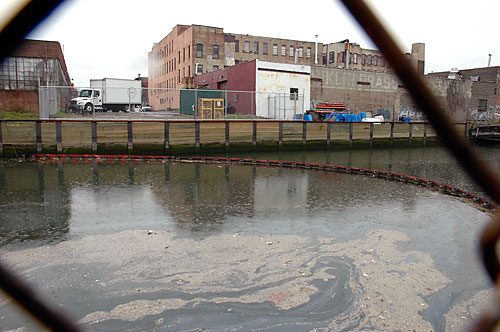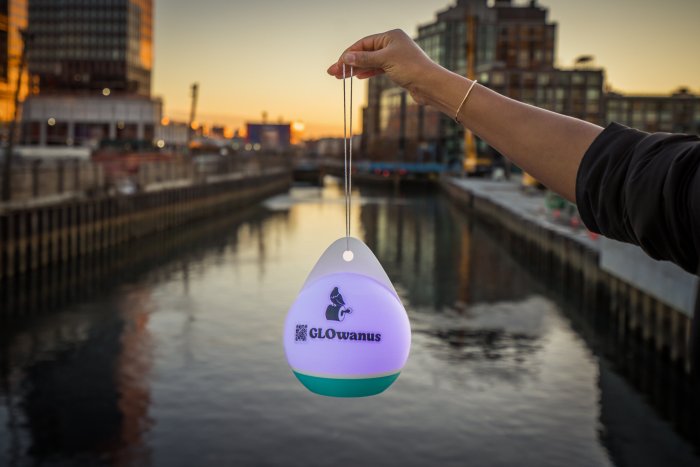Two competing proposals to clean up the Gowanus Canal were brought into stark relief on Tuesday night as federal officials pitched an approach that drags corporate polluters into lengthy court battles, and city officials unveiled an untested approach that seeks to clean the waterway by soaking federal taxpayers.
The fight between Mayor Bloomberg and the Environmental Protection Agency is a classic disagreement over whether to use the carrot or the stick to implement public policy. Bloomberg administration officials say that offering incentives to corporations to pay for some canal cleansing will work better than the EPA approach of suing polluters to finance the clean-up — the Superfund approach that is currently on the table.
EPA officials told more than 200 people in PS 32 on Hoyt Street on Tuesday night that the Superfund program has a proven record of results. It dates to 1980 and has cleaned hundreds of polluted sites across the country (though 1,600 have made it on to the Superfund list). The agency also claimed that it’s better equipped than the city’s grab bag of initiatives to direct a complex cleanup in the water and on land involving up to 150 property owners.
Not only that, but neighbors allegedly won’t wait years for progress on the waterway.
“Clean-up always comes first. We don’t hold it up while litigation is going on,” said Walter Mugdan, who directs the EPA’s Superfund program in New York and New Jersey.
That’s a bold claim given the glaring examples of delays on EPA-led efforts on the Hudson and Passaic rivers.
But Mugdan and his green team argued that their approach would extract the necessary $300 million to $400 million from identifiable polluters to remove the high levels of PCBs, dioxin and other toxins that accumulated on the canal’s bed from 150 years of industrial dumping.
The feds also claimed that, contrary to the mayor’s concerns, the proposed Superfund listing would not hamper existing city plans to make infrastructure improvements that would reduce sewage overflows into the canal.
And while the Superfund won’t interfere with the city work scheduled to begin this fall, it’s not going to help solve the annual 300-million gall spill either, because this “water quality” issue is in the state’s jurisdiction.
Mayor Bloomberg has been an outspoken critic of the federal proposal, saying that his team can do a Superfund-equivalent clean-up in less time.
His administration’s plan, presented in greater detail than it was two weeks ago, hinges on obtaining an inordinate allotment of federal taxpayer money through a program run by the US Army Corps of Engineers.
Instead of largely seeking corporate penalties, this formula is more dependent on generous yearly congressional earmarks from a program that only has $50 million to spend across the entire country.
Mugdan called that one of the main flaws.
“This is likely to take longer than Superfund once it starts because of the annual authorization restraints,” Mugdan warned.
The city expects challenges, but not insurmountable hurdles, because cleaning the Gowanus is now high on the mayor’s priorities.
“This project is at the top of the mayor’s federal agenda,” said Caswell Holloway, the chief of staff to Deputy Mayor Ed Skyler.
Under this scenario, American taxpayers would foot the bill for 65 percent of the clean-up. The Bloomberg Administration argues that this would entice corporate offenders to pay for the rest, helping to avoid the likely litigation between polluters and the federal government that can emerge from a Superfund designation.
“This would be a major incentive for [potentially responsible parties] to come to the table,” said Dan Walsh, the director of the Mayor’s office of Environmental Remediation.
Plus, it would facilitate the residential transformation of the surrounding manufacturing blocks favored by the mayor and already in the early stages with large apartment complexes planned by Toll Brothers and a collection of developers on the city owned Public Place site, both on the western shore of the canal.
The debate has energized the community — as shown by the turnout in PS 32 — and with the July 8 deadline for public comment fast approaching, many people have already chosen whether to support or oppose declaring the 1.8-mile long canal a Superfund site.
Among activists, there appears to be a significant minority who agrees with the mayor’s rationale that the Superfund would hinder development in the area.
The majority is made of people who welcome the intervention of the federal government after years of city neglect under several mayors.
“My priority is for the Gowanus Canal and its surrounding area to be cleaned up as quickly and efficiently as possible,” said Bob Zuckerman, who is not only the chairman of CB6’s Environmental Protection Committee and a candidate for City Council, but is also the former head of the Gowanus Canal Conservancy. “After comparing the EPA’s approach to the city’s, I am confident that a Superfund designation will result in a more comprehensive and coordinated cleanup of the canal.”
Supporters of Superfund designation like Zuckerman do make one good point: Why did the city wait decades to present a comprehensive clean-up plan until only after the EPA became involved?



















